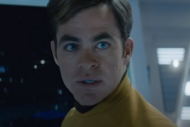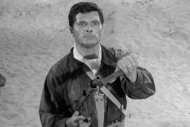Create a free profile to get unlimited access to exclusive videos, sweepstakes, and more!
Star Trek: Picard kills a fan favorite, becomes a hardcore sequel to Star Trek: Voyager

As the Star Trek series that continues the adventures of Jean-Luc Picard, Star Trek: Picard is both a direct sequel to TV series The Next Generation and the film Star Trek: Nemesis. But now, with Episode 5 of Picard — "Stardust City Rag" — the series just revealed it is also a gritty, super-hardcore sequel to TNG's sister-series, Star Trek: Voyager.
In fact, in this latest installment, the canon of Voyager is just as important — if not more important — than anything that ever happened in The Next Generation. The show may be named after Patrick Stewart's famous character, but with the latest twists and surprise character returns, Picard is proving itself to be a confluence of all Trek lore. And this time out, it's taking a hard look at would really happen after the starships USS Enterprise and USS Voyager came home.
**Spoiler Warning: There are spoilers ahead for Star Trek: Picard, Season 1, Episode 5, "Stardust City Rag."**
In every episode thus far, Picard has made it clear that not only is the world of 2399 a lot messier than the 24th century we left behind in TNG and Voyager, but that things have been messy for awhile.
As is becoming Picard's trademark, we again begin in flashback; this time, it's 13 years prior to the series, and we're somewhere called "The Five Domes." A familiar-looking young guy in a Starfleet uniform is getting brutally dissected by someone in surgical gear; this doctor/butcher is looking for his "cortical node." This guy is an Ex-Borg, but not just any Ex-Borg, it's Icheb, the teenage former Borg basically adopted by Seven of Nine in Star Trek: Voyager.
Tragically, the villains drilling into Icheb's skull to harvest his cortical node are wasting their time, and that's because longtime Voyager fans know that Icheb actually donated his cortical node to save Seven's life back in the episode "Imperfection." If you watch that episode right after this new episode of Picard, you'll be crying twice.
Seven rushes into to save Icheb (Casey King) from the illegal and awful surgery, but it's too late. She says she'll stay with him as he dies, but he asks her to basically zap him now. With tears in her eyes, Seven shoots Icheb in what has to be the most tragic opening to any Star Trek episode, ever. Although Icheb (originally played by Manu Intiraymi) joined the crew of Voyager in Season 6, he is still basically their version of Wesley Crusher, an innocent person who is saved by the heroics of Captain Janeway and Starfleet.
But now, it was all for nothing. At its midway point in its first season, Picard just killed off a beloved Voyager character, essentially to signal that if you didn't think the stakes were real on this series, here's a reminder: a dude who was a child on Voyager just got his face ripped off by a mysterious villain and then mercy-killed by his surrogate mother.
The story of Seven's quest for revenge against the villainous Bjayzl (Necar Zagegan) is the true drama in this episode, regardless of anything going on with Picard and the crew of the Le Sirena. "Stardust City Rag," might seem like a zany romp in which Rios and Jean-Luc don absurd disguises in order to infiltrate a seedy crime planet, but the reality is this is an episode about what the final frontier looks like when you're not seeking out new life and boldly going.
Once we get to the shady planet of Freecloud, there are not one — but two — references to the bartender, wheeler-and-dealer Quark from Deep Space Nine — Quark is mentioned in dialogue when Rios is undercover, and there's a holographic sign for a bar called "Quark's visible when Rios first beams-down. These Quark references are telling because the bar in Stardust City has more in common with the shades of grey on DS9 than anything from TNG or Voyager. Pretty quickly, we learn that Seven of Nine has joined a pseudo-vigilante group called the Fenris Rangers in order to help keep some semblance of peace in what used to be the Romulan Neutral Zone. And, it turns out harvesting Borg tech from former drones isn't just limited to what's going on aboard the Borg artifact.
Back in Episode 3, Hugh and Soji commiserated about the callous way the Romulans were treating the Ex-Borg, but honestly, what's going on there is nothing compared to the racket Bjayzl is running. In this part of the galaxy, it's pretty clear that getting cybernetic parts from former Borg is a big — and deeply gross — business. (The concept of criminals harvesting former Borg Drones actually comes from the Voyager episode, "Imperfection." But in that episode, it was happening all the way in the Delta Quadrant.)
Picard isn't visiting Freelcoud to intentionally facilitate Seven's revenge — he doesn't know he's helping make that happen until it's too late. After Seven agrees to act as bait for Bjayzl, in order to trick her into handing over Bruce Maddox, everything goes to hell pretty quickly. True to TNG form, Picard and Rios manage to talk themselves out of a stand-off, and Bruce Maddox is released to them, even though he's been pretty badly beat-up. Maddox also makes a reference to not being able to repay a loan to Bjayzl; but at this point, we don't know if that loan was monetary, or perhaps technological.
Did Maddox get harvested Borg tech from Bjayzl's operation? Was some of that stolen Borg tech then used to create Soji and Dahj? At this point, we don't know, but it seems pretty clear that at some point the nature of Maddox's loan might come to light later in the season.
"Stardust City Rag" is bookended by true darkness. After convincing Picard she won't seek revenge, Seven of Nine beams back down to Freecloud and kills Bjayzl anyway. Meanwhile, Raffi tries to reunite with her own estranged son and admits she's no longer taking any kind of illegal drugs. Sadly, her son doesn't care and tells her all her crazy conspiracy theories about the Mars attacks made her a bad mom and tells her to get lost and never come back.
Picard admits to Seven he didn't regain all of his humanity after being Borg-ifed. Maddox is in bad shape and near death. And Seven of Nine is killing people in cold blood because she's basically become a Trek version of Hawkeye's Ronin character in Avengers: Endgame. And just when you think things couldn't get worse, things get way worse. Seemingly out of nowhere, Dr. Jurati adjusts the controls on Maddox's medical instruments when no one is looking. The EMH shows up for a second to figure out what's going on, but she deactivates him. She tells Maddox that she has to "atone" for her role in the creation of Dahj and Soji, and that she wishes that "I didn't know what I know. I wish they hadn't told me." Then, Dr. Jurati, the sweetest character on the show so far, turns out to be a killer, too.
It's a great cliffhanger (is Jurati a spy? a robot?), but some Trek alarmists might cry foul about just how dark this episode got. But because the person with the sole writing credit on "Stardust City Rag" is long-time Voyager novelist Kirsten Beyer, we might want to trust that she knows what she's doing here. Back when it debuted in 1995, Voyager was poised to be a slightly grittier Trek, if only because its crew was cut-off from the rest of the Federation.
Ultimately, despite being pretty cool in its own right, Voyager never really lived up to its potential as a slightly wilder and looser Star Trek, instead mostly retained the buttoned-up feeling of The Next Generation. Even when you rewatch great episodes (like "Unimatrix Zero" or "Dark Frontier") you get the feeling the writers were pulling their punches a little bit. With "Stardust City Rag," Beyer's writing seems to approach the characters and situations from Voyager with a hard question: Okay, so what would happen to these people if Captain Janeway wasn't there to protect them? What if we took all of this a little more seriously?
"Stardust City Rag" scans as a legitimate response to some of the darker themes lurking underneath the surface in both Voyager and The Next Generation. According to several interviews, when Nicholas Meyer set out to rewrite the script for Star Trek II: The Wrath of Khan, his goal was to take the characters more seriously than anyone had taken them before. In this way, "Stardust City Rag" feels like Kirsten Beyer's The Wrath of Khan. No one episode of Trek has ever looked at the world of Voyager through this kind of lens. And the larger canon of Trek will never be the same again.
Is it all too dark for Star Trek? Some will say it is, but those same criticisms were aimed at First Contact (directed by Jonathan Frakes in 1996, who also directed this episode) as well as The Wrath of Khan. After all, this is only one chapter in a larger story, meaning there's still plenty of time for those Star Trek rays of sunshine to poke their way through the dark. Or, as Seven says of Picard himself, "Somebody's got to have a little bit of hope out here."
Star Trek: Picard is at its Season 1 halfway point. The next five episodes air on Thursdays on CBS All Access.





























